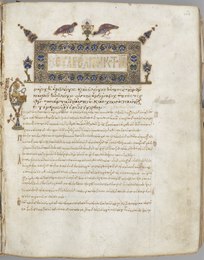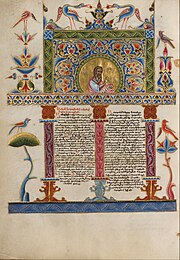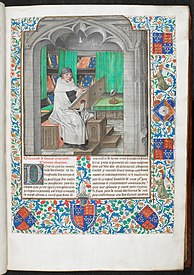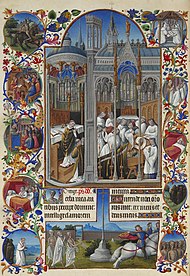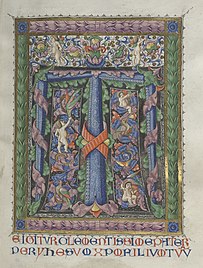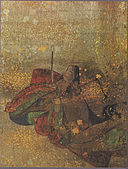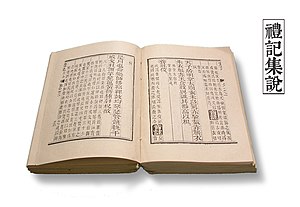Illuminated manuscript
An illuminated manuscript is a formally prepared
The earliest surviving illuminated manuscripts are a small number from late antiquity, and date from between 400 and 600. Examples include the Vergilius Romanus, Vergilius Vaticanus, and the Rossano Gospels.[3] The majority of extant manuscripts are from the Middle Ages, although many survive from the Renaissance. While Islamic manuscripts can also be called illuminated and use essentially the same techniques, comparable Far Eastern and Mesoamerican works are described as painted.
Most manuscripts, illuminated or not, were written on
Paper manuscripts appeared during the
The introduction of printing rapidly led to the decline of illumination. Illuminated manuscripts continued to be produced in the early 16th century but in much smaller numbers, mostly for the very wealthy. They are among the most common items to survive from the Middle Ages; many thousands survive. They are also the best surviving specimens of medieval painting, and the best preserved. Indeed, for many areas and time periods, they are the only surviving examples of painting.
History

Latin Europe
Art historians classify illuminated manuscripts into their historic periods and types, including (but not limited to)
Other illuminated liturgical books appeared during and after the Romanesque period. These included
As the production of manuscripts shifted from monasteries to the public sector during the High Middle Ages, illuminated books began to reflect secular interests.[1] These included short stories, legends of the saints, tales of chivalry, mythological stories, and even accounts of criminal, social or miraculous occurrences. Some of these were also freely used by storytellers and itinerant actors to support their plays. One of the most popular secular texts of the time were bestiaries. These books contained illuminated depictions of various animals, both real and fictional, and often focused on their religious symbolism and significance, as it was a widespread belief in post-classical Europe that animals, and all other organisms on Earth, were manifestations of God. These manuscripts served as both devotional guidance and entertainment for the working class of the Middle Ages.[10][11]
The Gothic period, which generally saw an increase in the production of illuminated books, also saw more secular works such as
Up to the 12th century, most manuscripts were produced in monasteries in order to add to the library or after receiving a
By the 14th century, the
Greek Europe and the Islamic world

The
The origins of the pictorial tradition of Arabic illustrated manuscripts are uncertain. The first known decorated manuscripts are some
An explosion of artistic production in Arabic manuscripts occurred in the 12th and especially the 13th century.
The Persian miniature tradition mostly began in whole books, rather than single pages for muraqqas or albums, as later became more common. The Great Mongol Shahnameh, probably from the 1330s, is a very early manuscript of one of the most common works for grand illustrated books in Persian courts.
Techniques
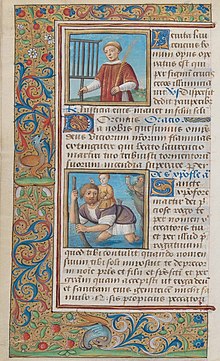
Illumination was a complex and costly process, and was therefore usually reserved for special books such as altar bibles, or books for royalty. Heavily illuminated manuscripts are often called "luxury manuscripts" for this reason. In the early Middle Ages, most books were produced in monasteries, whether for their own use, for presentation, or for a commission. However, commercial scriptoria grew up in large cities, especially Paris, and in Italy and the Netherlands, and by the late 14th century there was a significant industry producing manuscripts, including agents who would take long-distance commissions, with details of the heraldry of the buyer and the saints of personal interest to him (for the calendar of a book of hours). By the end of the period, many of the painters were women, especially painting the elaborate border, and perhaps especially in Paris.
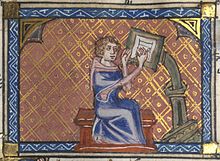
Text
The type of script depended on local customs and tastes. In England, for example, Textura was widely used from the 12th to 16th centuries, while a cursive hand known as Anglicana emerged around 1260 for business documents.[24] In the Frankish Empire, Carolingian minuscule emerged under the vast educational program of Charlemagne.[25]
The first step was to send the manuscript to a
The sturdy Roman letters of the early
Engrossing: The process of illumination


I. Charcoal powder dots create the outline II. Silverpoint drawing is sketched III. Illustration is retraced with ink IV. The surface is prepared for the application of gold leaf V. Gold leaf is laid down VI. Gold leaf is burnished to make it glossy and reflective VII. Decorative impressions are made to adhere the leaf VIII. Base colors are applied IX. Darker tones are used to give volume X. Further details are drawn XI. Lighter colors are used to add particulars XII. Ink borders are traced to finalize the illumination

The following steps outline the detailed labor involved to create the illuminations of one page of a manuscript:
- Silverpoint drawing of the design is executed
- Burnished gold dots are applied
- Application of modulating colors
- Continuation of previous three steps in addition to outlining marginal figures
- Penning of a rinceau appearing in the border of page
- Finally, marginal figures are painted[28]
The illumination and decoration was normally planned at the inception of the work, and space reserved for it. However, the text was usually written before illumination began. In the Early Medieval period the text and illumination were often done by the same people, normally monks, but by the High Middle Ages the roles were typically separated, except for routine initials and flourishes, and by at least the 14th century there were secular workshops producing manuscripts, and by the beginning of the 15th century these were producing most of the best work, and were commissioned even by monasteries. When the text was complete, the illustrator set to work. Complex designs were planned out beforehand, probably on wax tablets, the sketch pad of the era. The design was then traced or drawn onto the vellum (possibly with the aid of pinpricks or other markings, as in the case of the Lindisfarne Gospels). Many incomplete manuscripts survive from most periods, giving us a good idea of working methods.
At all times, most manuscripts did not have images in them. In the early Middle Ages, manuscripts tend to either be display books with very full illumination, or manuscripts for study with at most a few decorated initials and flourishes. By the Romanesque period many more manuscripts had decorated or
Paints
While the use of gold is by far one of the most captivating features of illuminated manuscripts, the bold use of varying colors provided multiple layers of dimension to the illumination. From a religious perspective, "the diverse colors wherewith the book is illustrated, not unworthily represent the multiple grace of heavenly wisdom."[13]
The medieval artist's palette was broad:[29]
| Color | Source(s) |
|---|---|
| Red | Insect-based colors, including:
Chemical- and mineral-based colors, including:
|
| Yellow | Plant-based colors, such as:
Mineral-based colors, including:
|
| Green |
|
| Blue | Plant-based substances such as:
Chemical- and mineral-based colors, including:
|
| White |
|
| Black |
|
| Gold |
|
| Silver |
Gilding
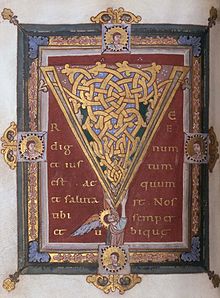
On the strictest definition, a manuscript is not considered "illuminated" unless one or many illuminations contained metal, normally
The application of gold leaf or dust to an illumination is a very detailed process that only the most skilled illuminators can undertake and successfully achieve. The first detail an illuminator considered when dealing with gold was whether to use gold leaf or specks of gold that could be applied with a brush. When working with gold leaf, the pieces would be hammered and thinned.[30] The use of this type of leaf allowed for numerous areas of the text to be outlined in gold. There were several ways of applying gold to an illumination. One of the most popular included mixing the gold with stag's glue and then "pour it into water and dissolve it with your finger."[31] Once the gold was soft and malleable in the water, it was ready to be applied to the page. Illuminators had to be very careful when applying gold leaf to the manuscript because gold leaf is able to "adhere to any pigment which had already been laid, ruining the design, and secondly the action of burnishing it is vigorous and runs the risk of smudging any painting already around it."
Patrons
Monasteries produced manuscripts for their own use; heavily illuminated ones tended to be reserved for liturgical use in the early period, while the monastery library held plainer texts. In the early period manuscripts were often commissioned by rulers for their own personal use or as diplomatic gifts, and many old manuscripts continued to be given in this way, even into the
Gallery
-
Leaf from a Byzantine Psalter and New Testament; 1079; ink, tempera and gold on vellum; sheet: 163 × 109 mm; Cleveland Museum of Art (Cleveland, Ohio, US)
-
Detail from Bifolium with Christ in Majesty in an Initial A, from an Antiphonary; c. 1405; tempera, gold, and ink on parchment; Metropolitan Museum of Art (New York City)
-
Leaf from a Book of Hours; c. 1460; ink, tempera and gold on vellum; leaf: 197 × 143 mm; Cleveland Museum of Art
-
Detail of a L from Benedictine Antiphonary; by Belbello da Pavia; c. 1467–1470; tempera, gold, and ink on parchment, binding: leather over wood boards with copper alloy corner mounts and bosses; Metropolitan Museum of Art
-
Leaf from a Gradual: Initial P with the Nativity; 1495; ink, tempera and gold on vellum; each leaf: 598 × 41 mm; Cleveland Museum of Art
-
Hours of Queen Isabella the Catholic, Queen of Spain; c. 1500; ink, tempera, and gold on vellum; codex: 225 × 152 mm; Cleveland Museum of Art
-
Farnese Hours, an example of a Renaissance illuminated page; by Giulio Clovio; 1537–1546; illumination on parchment; 171 × 111 mm; Morgan Library & Museum (New York City)
-
Four Evangelists; 1572–1585; 413 × 277 mm; from Italy, probably Rome; Morgan Library & Museum
-
Al-Quran, 1591–92, from Safavid Iran; Turkish and Islamic Arts Museum(Istanbul)
-
Example of an elaborately decorated border of a Sikh illuminated manuscript from a 17th century Guru Granth Sahib manuscript kept at Gurdwara Mattan Sahib in Martand, Kashmir, India. It is known as the Sunehri bir (golden corpus)
See also
References
- ^ ISBN 978-1-316-48020-5.
- ISBN 978-0-88844-194-2.
- ISBN 978-0-7011-2243-0.
- JSTOR 41339989.
- ^ ISBN 978-0-8020-8173-5.
- ISBN 978-1-60606-578-5.
- ^ Mark, Joshua J. "Book of Kells". World History Encyclopedia. Retrieved 12 April 2024.
- ^ "The Psalter as Scripture - Response - Seattle Pacific University". spu.edu. Retrieved 12 April 2024.
- ^ Stein, Authors: Wendy A. "The Book of Hours: A Medieval Bestseller | Essay | The Metropolitan Museum of Art | Heilbrunn Timeline of Art History". The Met’s Heilbrunn Timeline of Art History. Retrieved 12 April 2024.
- ^ "The Getty Museum". Getty Museum. Retrieved 17 April 2024.
- ^ penelope.uchicago.edu https://penelope.uchicago.edu/~grout/encyclopaedia_romana/britannia/anglo-saxon/flowers/bestiary.html. Retrieved 17 April 2024.
{{cite web}}: Missing or empty|title=(help) - ISBN 978-1-884446-05-4.
- ^ a b c Putnam, George Haven (1897). Books and their makers during the Middle Ages: A study of the conditions of the production and distribution of literature from the fall of the Roman Empire to the close of the seventeenth century. London: Putnam.
- ^ Flood, Finbarr Barry (2017). "A Turk in the Dukhang? Comparative Perspectives on Elite Dress in Medieval Ladakh and the Caucasus". Interaction in the Himalayas and Central Asia. Austrian Academy of Science Press: 232.
- ^ Hillenbrand 2010, p. 126 and note 40.
- sharbūshas markers of official status (...) the combination is standard, even being reflected in thirteenth-century Coptic paintings, and serves to distinguish, in Grabar's formulation, the world of the Turkish ruler and that of the Arab. (...) The type worn by the official figures in the 1237 Maqāmāt, depicted, for example, on fol. 59r,67 consists of a gold cap surmounted by a little round top and with fur trimming creating a triangular area at the front which either shows the gold cap or is a separate plaque. A particular imposing example in this manuscript is the massive sharbūsh with much more fur than usual that is worn by the princely official on the right frontispiece on fol. 1v."
- ^ a b Snelders 2010, p. 3, note 14.
- ^ a b Snelders 2010, p. 3.
- ^ Snelders 2010, p. Chapter4, 4th page.
- ISBN 978-0-87099-777-8.
- ^ ISBN 978-0-87099-777-8.
- ^ Snelders 2010, pp. 1–2.
- ^ Snelders 2010.
- ISBN 978-0-521-80315-1.
- S2CID 241300499.
- ^ ISBN 978-0-7141-2049-2.
- ISBN 978-0-03-068625-2.
- S2CID 190805404.
- ISSN 2050-7445.
- ^ ISBN 978-0-7123-5668-8.
- JSTOR 1451766.
Sources
- Alexander, Jonathan A.G., Medieval Illuminators and their Methods of Work, 1992, Yale UP, ISBN 0300056893
- Coleman, Joyce, Mark Cruse, and Kathryn A. Smith, eds. The Social Life of Illumination: Manuscripts, Images, and Communities in the Late Middle Ages (Series: Medieval Texts and Cultures in Northern Europe, vol. 21. Turnhout: Brepols Publishing, 2013). xxiv + 552 pp online review
- Calkins, Robert G. Illuminated Books of the Middle Ages. 1983, Cornell University Press, ISBN 0500233756
- Camille, M. (1992). Image on the edge: the margins of medieval art. Harvard University Press.
- Contadini, Anna (1 January 2012). A World of Beasts: A Thirteenth-Century Illustrated Arabic Book on Animals (the Kitāb Na't al-Ḥayawān) in the Ibn Bakhtīshū' Tradition. Brill. .
- De Hamel, Christopher. A History of Illuminated Manuscript (Phaidon, 1986)
- Hillenbrand, Robert (1 January 2010). "The Schefer Ḥarīrī: A Study in Islamic Frontispiece Design". Arab Painting: 117–134. ISBN 978-90-04-23661-5.
- Kren, T. & McKendrick, Scot (eds), Illuminating the Renaissance – The Triumph of Flemish Manuscript Painting in Europe, Getty Museum/Royal Academy of Arts, 2003, ISBN 1-903973-28-7
- Liepe, Lena. Studies in Icelandic Fourteenth Century Book Painting, Reykholt: Snorrastofa, rit. vol. VI, 2009.
- Melo, M.J., Castro, R., Nabais, P. et al. The book on how to make all the colour paints for illuminating books: unravelling a Portuguese Hebrew illuminators' manual' ' Herit Sci 6, 44 (2018). https://doi.org/10.1186/s40494-018-0208-z
- Morgan, Nigel J., Stella Panayotova, and Martine Meuwese. Illuminated Manuscripts in Cambridge: A Catalogue of Western Book Illumination in the Fitzwilliam Museum and the Cambridge Colleges (London : Harvey Miller Publishers in conjunction with the Modern Humanities Association. 1999– )
- Pächt, Otto, Book Illumination in the Middle Ages (trans fr German), 1986, Harvey Miller Publishers, London, ISBN 0199210608
- ISBN 9781783742356

- Snelders, B. (2010). Identity and Christian-Muslim interaction : medieval art of the Syrian Orthodox from the Mosul area. Peeters, Leuven.
- Wieck, Roger. "Folia Fugitiva: The Pursuit of the Illuminated Manuscript Leaf". The Journal of the Walters Art Gallery, Vol. 54, 1996.
External links
- Thompson, Edward M. (1911). . Encyclopædia Britannica. Vol. 14 (11th ed.). pp. 312–320.
Images
- Illuminated Manuscripts in the J. Paul Getty Museum – Los Angeles (archived 17 September 2006)
- Illuminated Manuscript Leaves. Digitized illuminated manuscripts from the University of Louisville Libraries.
- 15 pages of illuminated manuscripts from the Ball State University Digital Media Repository
- Digitized Illuminated Manuscripts – Complete sets of high-resolution archival images from the Walters Art Museum
- Collection of Armenian Illuminated Manuscripts – A full collection with high resolution images of Armenian Illuminated Manuscripts
Resources
- UCLA Library Special Collections collection of Medieval and Renaissance manuscripts
- British Library, catalogue of illuminated manuscripts
- Collection of illuminated manuscripts from the Museum Meermanno-Westreenianumin The Hague.
- CORSAIR. Thousands of digital images from the Morgan Library's renowned collection of medieval and Renaissance manuscripts
- Manuscript Miniatures, a collection of illustrations from manuscripts made before 1450
- A Collection of Indonesian Illuminated Manuscripts | Southeast Asia Digital Library
Related articles

